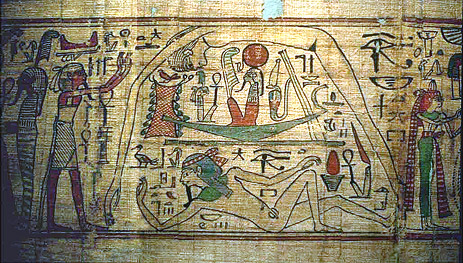Image Resource Bank
Image Gallery |  1 of 15
1 of 15 
Eleventh-century BCE Egyptian Funerary Papyrus Showing Nut and Geb
This papyrus depicts part of the ancient Egyptian creation myth cycle. Usually such myths of the ancient Near East envisioned the world as controlled by a multitude of gods who related to one another much as humans do in real life, but these gods (and goddesses) were associated with various natural phenomena, so their behavior had cosmic consequences. In the middle of the picture the body of the goddess Nut, who represents the starry sky, can be seen arching over the recumbent figure of her brother Geb, representing the earth. (Some said that earthquakes occurred when Geb laughed.) Nut was married to the sun-god Ra, but was in love with her brother Geb; and when the two joined together in lovemaking, there was no space between earth and sky for light, and the world became dark. So their father, the air-god Shu, held them apart, allowing Ra to pass between and bring light to the world during the day. In the middle of the picture, one can see Ra, with the sun disc on his head, riding in his boat above Geb and beneath Nut.
Name: Egyptian Funerary Papyrus Showing Nut and Geb
Material: Black ink, pigment on papyrus
Size: Section from a larger papyrus Height: 19.3 cm
Width: 270 cm
Date: ca. 1069-945 BCE, 21st Dynasty, Third Intermediate Period
Place of Origin: Book of mythological images in the name of Nespakashuty, accountant of the granaries of Amun
Location: The Louvre, Paris
Registration # and Source: World Images. Link to resource![]() (accessed April 27, 2010).
(accessed April 27, 2010).
Attribution: Work of Kathleen Cohen
Location: WorldImages Kiosk, California State University

 Fred M. Donner
Fred M. Donner
Professor of Near Eastern History, University of Chicago




